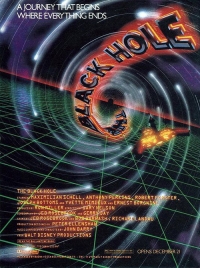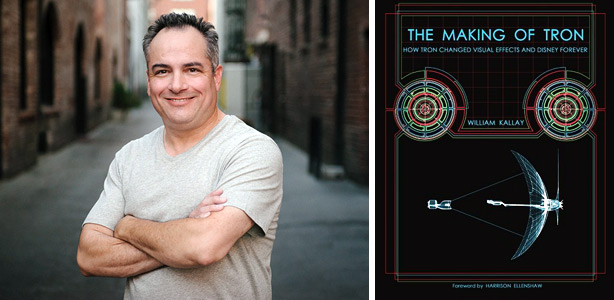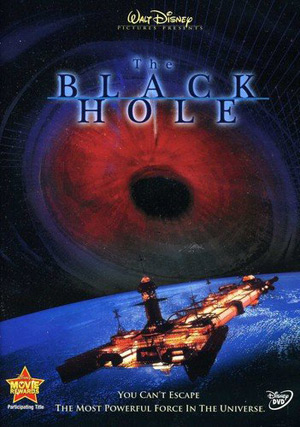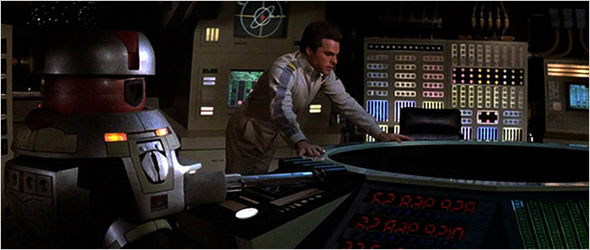
And, in case you missed them or desire a refresher read, this column’s other Disney-themed retrospectives include Fantasia 75th anniversary, The Little Mermaid 25th anniversary, Mary Poppins 50th anniversary, and Tron 35th anniversary.
William Kallay is the author of The Making of Tron: How Tron Changed Visual Effects and Disney Forever (2011).
William is the co-founder of FromScriptToDVD.com, where he has written about film technology, interviewed filmmakers, and reviewed countless DVDs and Blu-ray Discs. Green Tea, Kallay’s 2004 short film, won the Outstanding Writing Commendation Award from the 48 Hour Film Festival in Los Angeles. He has also written for Go (the official magazine for AirTran Airways) and Widescreen Review.
Kallay kindly spoke to The Bits about the appeal and legacy of The Black Hole.
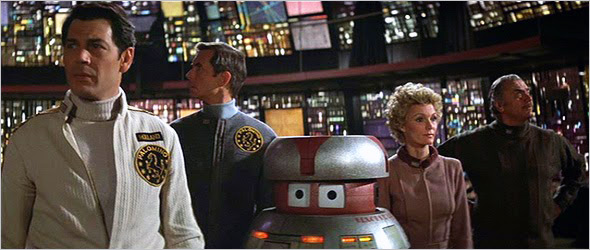
Michael Coate (The Digital Bits): How would you like for The Black Hole to be remembered on its 40th anniversary?
William Kallay: The film should be remembered on a few different levels. In the late 1970s, cinema was undergoing immense change due to the success of Jaws (1975), Star Wars (1977), and Superman: The Movie (1978). Hollywood was still reeling from the end of the big budget box office failures of the 1960s to the embrace of low budget, counterculture films such as Easy Rider (1969) and Billy Jack (1971). The industry was stuck in neutral, yet it was looking for movies to succeed just to survive.
Studios were being sold to huge corporations with no film background. Some studio back lots were being sold for real estate development. A young group of new filmmakers was rising with Steven Spielberg, George Lucas, Francis Ford Coppola and Martin Scorsese.
Walt Disney Productions during much of this period was still grounded on films that Walt might have approved of. By the late 1970s, Walt Disney Productions kept making films as though they were made in 1963. Simple storylines, the same music, the same title sequences, the same actors etc. By this time, children growing up in the ’70s had embraced edgier films like Jaws, or The Bad News Bears (1976). They could handle watching movies with some violence and bad words. Disney, however, played it safe and kept releasing films like Gus and One of Our Dinosaurs is Missing (both 1976).
By the time The Black Hole was released in theaters, it seemed that Disney finally made a film that was going to be a blockbuster. The concept of the film was exciting about a small space crew who discovers a seemingly abandoned spaceship teetering on the edge of a black hole, only to find a lot of danger. Mind you, Alien came out in May of that year, seven months before The Black Hole. That concept had a small space crew discover a seemingly abandoned spaceship on a desolate planet, only for all hell to break loose. So the coincidence was most likely accidental. Keep in mind that the story and concept for The Black Hole was written in 1974 (originally titled Space Probe One).
The Black Hole had an exciting story concept with the black hole, stunning and incredible visual effects headed by the father and son duo of Peter and Harrison Ellenshaw, very credible actors, a haunting John Barry score (he was most famous for scoring the James Bond films of the era), and a fairly solid sound design. The film should also be recognized as Disney’s first attempt after the success of Mary Poppins (1964) for a blockbuster.
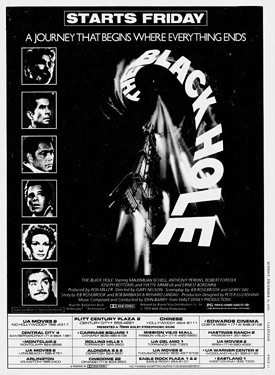 Coate: What do you remember about the first time you saw The Black Hole?
Coate: What do you remember about the first time you saw The Black Hole?
Kallay: My parents sent me to YMCA camp in the summer of 1979. One of the best and worst experiences of my youth, but I digress. When I got home from camp, my dad put aside my mail. One of the pieces of mail was Disney News magazine, which I later found out was simply a publicity magazine for the company. No matter. I wanted as much news about Disney as I could get.
On the cover was a beautiful painting of the U.S.S. Cygnus flying through outer space. This was the first time I saw publicity for The Black Hole. I flipped the pages to the article. Not much more than five pages, it provided me a glimpse into this new film with short a description of the story and production, along with stills. Plus the article said it would be released in 70mm Technovision. Heck, it must be good! I needed to see this film.
I had been living in Anaheim Hills, California, for a year by the time The Black Hole was released. By early December, my cousins were staying with us for a few weeks. My parents decided to pack us up in the car and drive down to the Cinedome in Orange. Cinedome was nothing like any other theater I had been to. Seeing a movie there was nirvana.
We saw Star Trek: The Motion Picture in one of the big domes a few weeks before. A few weeks later, when we went to see The Black Hole it was in one of the rectangular auditoriums. Not as good as seeing movies in the domes, but I was young and simply wanted to see the movie.
The lights faded and the curtains parted. The screen went black. A rousing orchestral theme played in the theater. It was loud and I loved it. What I did not realize at the time, this was the overture for The Black Hole composed by John Barry. I almost instantly remembered it after the movie was over and kept humming the overture on the way back home. Then Barry’s main theme played over the Cinedome speakers. It was eerie and there was not a Buena Vista Distribution logo on the screen. Computer typography filled the frame. This was unlike any Disney film I had seen before. The black hole was shown in then state-of-the-art computer vector graphics. The audience floated through outer space until we flew into the vortex. I was hooked.
There are so many memories of seeing this film, but what stuck with me was the fact that the film was kind of scary for a young kid. Earlier that year, I begged my parents to let me see Alien, but they did not think it was a good idea. Good call. But The Black Hole though maybe seen today as tame, had some scary elements.
Maximilian was the menacing robot henchman for Dr. Hans Reinhardt (played by actor Maximilian Schell). When Maximilian started showing off his blade skills, I was a bit frightened. When the film goes into the black hole sequence and we see the infamous Hell and Heaven scenes, I was completely mesmerized and yet scared. Mind you, the film had some “jump scares” in it. Even experiencing the film in 35mm Dolby Stereo, I jumped out of my seat a few times.
What really fixated me to the film were the astounding visual effects. Outer space seemed three dimensional and real. The star fields looked like how I imagined space. The black hole itself was very cool. There was some criticism of the design of it, but how else would you show something that in reality is apparently invisible?
Coate: In what way is The Black Hole a significant motion picture?
Kallay: It is significant because it showed that Walt Disney Productions was attempting to do something innovative and striking again. With The Black Hole they combined the elements of their own film past with an eye on the future of the studio’s existence.
This was the first Disney feature film to receive a PG rating. The studio had picked up distribution rights to an independent low budget movie called Take Down in 1979. That film was rated PG, but it was not a Disney produced film. The Black Hole rating was mainly from violence and scary elements within the film. Audiences, including Disney fans, sometimes forget that Walt Disney and his studio did some daring films that were not typical and pushed the boundaries. The studio did not always make wholesome entertainment. Heck, Pollyanna (1960) has nudity in the first minute of the film! Treasure Island, made ten years earlier, almost garnered Disney’s first PG rating in 1975 for its re-release due to a violent scene, but the studio trimmed it for a G rating.
As far as being a work of science fiction, I think most of the film works really well. If the script was a little stronger, the robots (though I love how McDowall and Pickens voiced the robots) were less cartoonish looking, the film probably would be more highly regarded.
I want to emphasize the brilliant production design of Peter Ellenshaw and the truly elegant matte paintings by Harrison Ellenshaw. Their teaming really established the look and tone of the film. The combination of Peter and Harrison’s artistic talents was a culmination Disney’s past and future. Peter had a huge influence with his visual effects work on 20000 Leagues Under the Sea and Mary Poppins, not to mention a plethora of work for Walt’s studio over the years.
Harrison established himself as a premiere matte painter on Star Wars, Pete’s Dragon (1977) and Big Wednesday (1978) before joining the production of The Black Hole. He had apprenticed under Disney matte department head, Alan Maley. Harrison clearly had an eye for painting photo-realistic mattes which added to the illusion that, for example, a soundstage set was much larger than it actually was.
Peter brought a Victorian era/cyberpunk element to the U.S.S. Cygnus. The spaceship simply looked beautiful and yet haunting. You knew, as an audience member, that some serious danger was lurking inside that ship. Harrison’s matte paintings are extraordinary. To this day, I am impressed that some shots in the film seem like they were sets, not matte paintings. A perfect example of his matte work was on the massive Cygnus interior corridor which seemed to stretch for miles.
It is noteworthy that Peter and Harrison, along with Eustace Lycett and Art Cruickshank, were nominated for an Oscar for Best Visual Effects for the film.
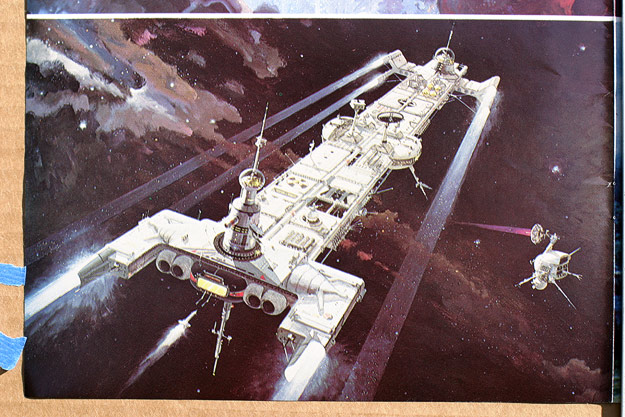
Coate: How would you describe The Black Hole to someone who has never seen it or to someone who has avoided seeing it because they dislike science-fiction and fantasy films or “old movies” or “kid flicks”?
Kallay: If you have never seen it, don’t expect Star Wars. Watch it for being an ambitious Disney answer to Star Wars. Watch it from the perspective of it signaling a change at Disney at that time. Watch it for the incredible sets, visual effects and a storyline that mimics 20000 Leagues under the Sea, but set in space.
Every science fiction film is a product of its day. Most of these types of films usually show their age due to their “futuristic” concepts, visual effects technology and costumes becoming dated. The Black Hole seen from today’s perspective actually holds up well. I am no scientist, but from my understanding, our understanding of the science of black holes has changed from the 1970s. So one who has never seen this film has to watch it for what it is: rousing entertainment. Most of the visual effects still hold up very well. Indeed, the wires holding up the “flying” robots were somewhat distracting even back in the day, but they did not have digital technology to remove them. The costumes do not hold up. I still chuckle seeing Yvette Mimieux wrapped up in what looks like aluminum foil. But you should watch it and re-discover fine veteran actors such as Robert Forster, Ernest Borgnine, Anthony Perkins and a young Joseph Bottoms.
We recently lost Robert Forster who passed away at the age of 78 in October 2019. He had been a well-respected actor long after starring in The Black Hole, but not always a marquee talent. He was well reviewed in Quentin Tarantino’s Jackie Brown (1997) and had a successful run on the TV show Last Man Standing (2012-2018) as Tim Allen’s TV father, Bud Baxter.
I recommend seeing this film on a big screen during a revival in 35mm or 70mm, if possible. Frank V. Phillips’ Oscar nominated cinematography is simply beautiful. I finally did see the 70mm version of it in 2010. The print was unfortunately faded and pink and some of the sound dropped out. But the print was very sharp and grain-free. If you don’t have access to seeing it on film, watch the Blu-ray on a big screen TV. This film was designed with a big wide screen viewing experience in mind. The scope of the beautiful mattes and sets is truly remarkable.
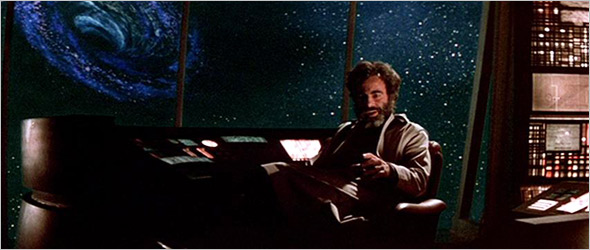
Coate: In what way was Gary Nelson an ideal choice to direct?
Kallay: Gary Nelson was a solid TV director who directed some very classic shows in the 1960s and 1970s. As a kid, I watched lot of 1960 era shows in syndication and some of them were numerous episodes of Get Smart that Nelson directed. Much to my surprise, he directed shows like Nanny and the Professor and Gilligan’s Island, as well.
One of Nelson’s overlooked films is the original Freaky Friday (1976). It was perhaps the one Disney family film that was mature during the 1970s. The mother/daughter relationship (played by Barbara Harris and Jody Foster) was brilliantly acted and Nelson brought out those performances with his assured direction. The film was a precursor for Nelson’s direction on The Black Hole.
When you watch The Black Hole and get beyond some of the dialogue (and yes, the robot wires), there is some very good acting and direction in it. Nelson, I felt, kept the film’s acting and plot direction on course.
Even though there were Disney elements in the film, Nelson made much of the film seem more like it could have been made at another studio. That was a steppingstone in the right direction to bring Disney into the modern age.
Coate: Has The Black Hole been treated well in its numerous home video editions?
Kallay: Not so well in my experience. I cannot remember which year it was, but one Christmas one of my gifts was a VHS copy of The Black Hole and it came with a Christmas ornament of Mickey Mouse as the Sorcerer’s Apprentice. Back in those days of early home video, it was simply exciting to see a major Hollywood motion picture on video.
Back in the early 1980s, home video quality was pretty atrocious, especially when widescreen films were panned-and-scanned for VHS. Viewers lost a huge amount of the original image. In watching it on my parent’s 13-inch TV, I recall the picture quality was murky. The colors of the visual effects were muted and the sound was flat. Still, it didn’t matter to me because I could watch one of my favorite movies at home.
Your question brought up a memory. When I went to Disneyland in those days, one of the stores on Main Street, U.S.A. used to sell clips from various Disney films on Super 8mm film. If I recall, you could buy certain scenes from The Black Hole on Super 8mm film!
I have not yet seen the recent Blu-ray of The Black Hole, so I cannot comment on its quality. But I can say that my good friends Harrison Ellenshaw and Ethan Dettenmaier did the audio commentary. [Ultimately, the Blu-ray was released without the audio commentary track. – Editor]
Coate: Where does The Black Hole rank among Disney live-action films?
Kallay: For me, in the top five of Disney live-action films made by 1980. My personal favorites are of course 20000 Leagues under the Sea, Mary Poppins, but I also have always liked Freaky Friday and The Absent Minded Professor (1961). As a kid who idolized all that was Star Wars, it was exciting for me to see Disney finally attempting to break their mold and still have signature Disney elements in it.
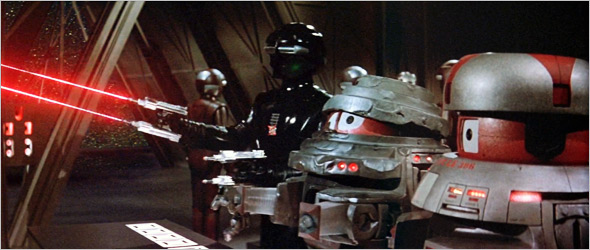
Coate: Where does The Black Hole rank among late 1970s/early 1980s sci-fi and fantasy films?
Kallay: In the top ten for me. The Black Hole was the last of the major sci-fi films during the 1970s and it had a lot of previous competition to measure up to. Soylent Green, Westworld (both 1973), Logan’s Run (1976), Star Wars, Close Encounters of the Third Kind (both 1977), Superman: The Movie (1978), Alien, Star Trek: The Motion Picture (both 1979) all preceded The Black Hole.
Coate: What is the legacy of The Black Hole?
Kallay: I think the best way to mention the legacy of The Black Hole is to remember what it tried to achieve. Disney finally realized by the late-70s that it needed to reinvent its film slate in order to survive. The Black Hole was its first calculated risk. Tron was its second in 1982.
There was a lot of eagerness by audiences to see The Black Hole. People, I believe, really wanted Disney to succeed. They wanted to see something creative, awe inspiring, and daring from the studio. Did they get that when the film was released? In some aspects yes and in some aspects no.
Disney could not at that time attract actors who were considered “A-list” stars. I think all of the actors in the film did great, but I think the casting hurt the film’s chances at the box office a bit. I do not recall any kids clamoring for an Ernest Borgnine “Harry Booth” action figure! A young Disney studio executive named Tom Wilhite knew the cast was not going to sell tickets, but the visual effects could, so he emphasized the Ellenshaw’s fine work.
The final film was met with some indifference by both audiences and critics alike. But there were a lot people that did really enjoy it. As much as people nitpicked about the robots, the meteor shower sequence and the fact that the Palomino crew somehow survives in outer space without spacesuits, the film as a whole is a good movie!
It was not a huge hit, but it did manage to eventually break even with its original release, a 70mm re-release in 1980 [sometimes double-billed with Sleeping Beauty], and it was an early and very successful home video title.
And talk about a legacy that the film left: Peter and Harrison Ellenshaw represented the past glory of the studio and its future. Peter cemented his reputation on 20000 Leagues under the Sea and Mary Poppins, and those two films only represent a fraction of his work for the studio. Harrison cemented his reputation on Star Wars and his matte paintings at Disney before he worked on The Black Hole. He would become an even more influential force at Disney with his work on Tron and would eventually head the highly respected and successful Buena Vista Visual Effects Group. The baton had been passed on and the Ellenshaw legacy at Disney would continue.
You want to know about the final legacy of The Black Hole? That the film’s ending, forty years later, is still debated and dissected!
Coate: Thank you, Bill, for sharing your thoughts on The Black Hole on the occasion of the 40th anniversary of its release.
---
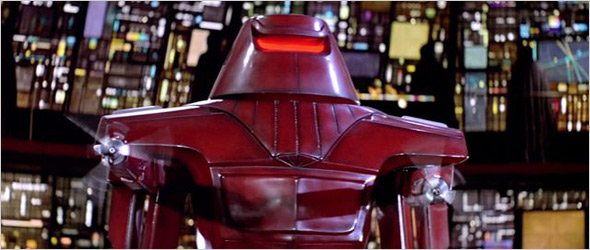
IMAGES:
Selected images copyright/courtesy Buena Vista Distribution, Los Angeles Times, Walt Disney Home Video, Walt Disney Productions, Walt Disney Studios Home Entertainment.
- Michael Coate
Michael Coate can be reached via e-mail through this link. (You can also follow Michael on social media at these links: Twitter and Facebook)


